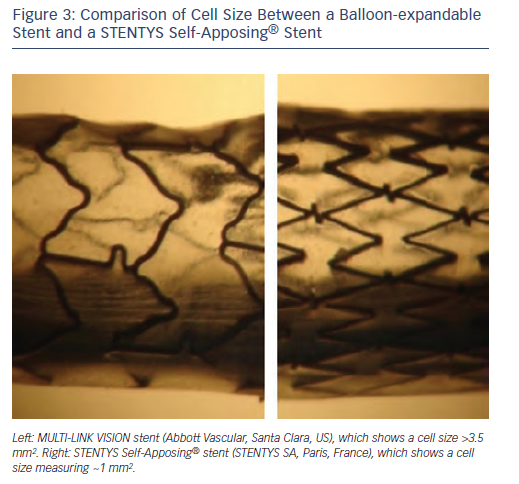How the STENTYS Self-Apposing® Stent Could Address These Issues
In ectatic, tapered or aneurysmal vessels, the STENTYS stent, due to its self-apposing design, is  able to appose itself all along the vessel even in cases of large diameter variations, thus avoiding malapposition. As a result, POT and complex ballooning such as the use of kissing balloons are not required (see Figure 1).
able to appose itself all along the vessel even in cases of large diameter variations, thus avoiding malapposition. As a result, POT and complex ballooning such as the use of kissing balloons are not required (see Figure 1).
The STENTYS stent can expand beyond the range indicated in case of tapered or ectatic vessels (see Figure 2). In particular, the large STENTYS stent is indicated for vessels from 3.5 to 4.5 millimetres (mm), but can be used in vessels up to 6.0 mm without additional treatment, if necessary.
Gentle deployment of the STENTYS stent from distal to proximal (see Figure 2) may capture loose thrombus and reduce the likelihood of thrombus dislodging and travelling distally during stent deployment. In addition, high pressure ballooning is not required during stent deployment,10 although low pressure post-dilation is advised to ensure sufficient stent expansion. Small cells (see Figure 3) also provide a cover for thrombus to reduce the degree of thrombus prolapse. The STENTYS stent could thus be a good solution in vessels with a large thrombus burden such as SVGs or in a STEMI patient, where distal embolisation and no-reflow occur more frequently than in stable cases.
In a STEMI patient, or in a CTO lesion, the vessel is often constricted and does not represent its true size, thus making sizing during the procedure difficult. In addition, the vessel size has been shown to increase days after the procedure once the vessel relaxes, vasospasm dissipates and thrombus dissolves.13 The STENTYS stent is self-expanding and one size covers a range of vessel diameters, which makes sizing during the procedure easier. The stent can also continue to expand post-procedure if the vessel undergoes positive remodelling, thus ensuring good apposition even over time.10
The disconnection feature of the STENTYS stent, which unlocks bridges at a side branch, can be used in the treatment of bifurcation lesions to create a wide enough opening to facilitate the deployment of additional stents or the use of devices, if deemed necessary by the operator. Due to the self-expanding nature of the STENTYS stent, malapposition in the main branch is not an issue, even when side branch access is granted.14 In addition, the stent apposes well to tapered main branch vessels, which are commonly found in the bifurcation anatomy. Drug delivery is maintained over the length of the stent, even at the side branch, as no strut deformation takes place.